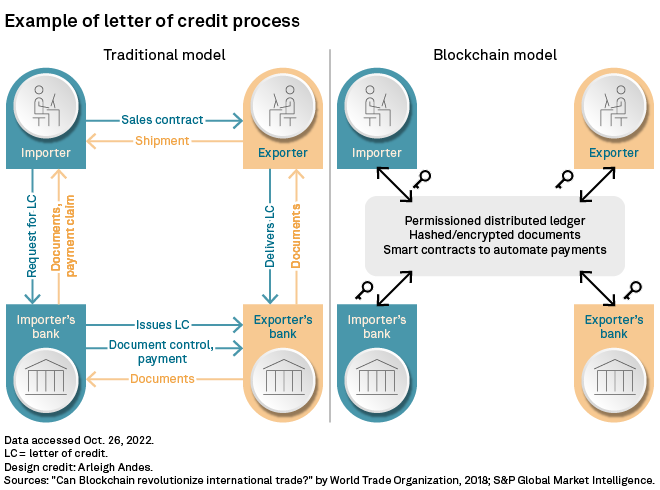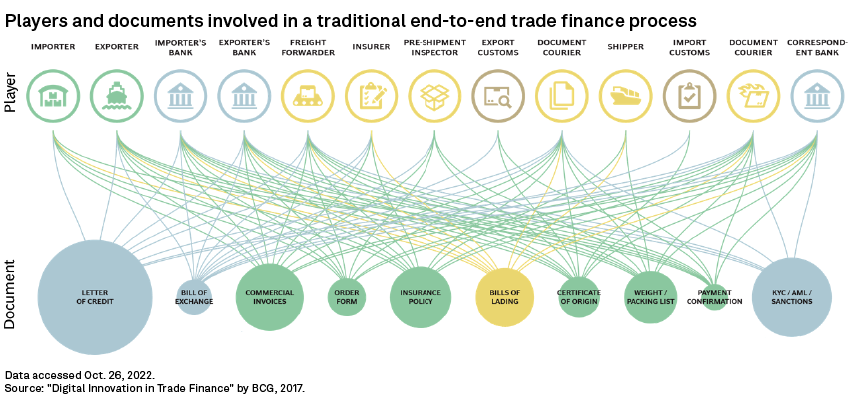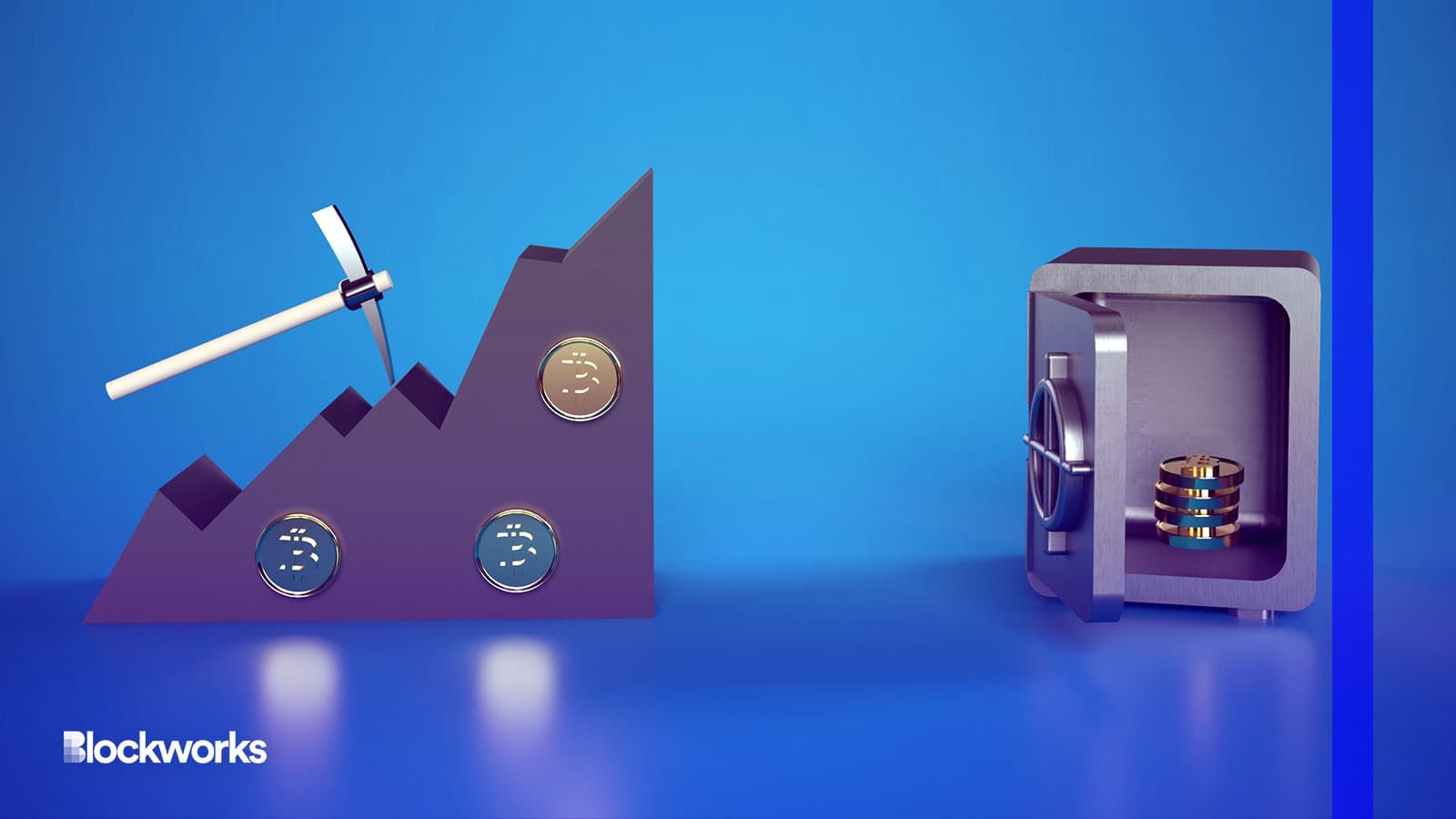The trade finance industry remains hopeful about blockchain despite failed projects
Banks and fintech firms remain optimistic that blockchain technology can help transform the paper-heavy trade finance industry, despite a recent spate of news about canceled projects and transitions to other technologies.
When Barclays PLC issued the world’s first blockchain-based letter of credit in 2016, it spoke of a coming “blockchain revolution in trade finance.” A transaction that would normally take up to 20 days was cut to less than four hours.
In the years that followed, trade finance players lined up behind countless proofs of concept, pilots and industry consortia to bring the promise of blockchain to life. Banking collaborations such as we.trade, Marco Polo Network, Contour, Komgo, Batavia and CordaKYC sought to build industry-wide platforms, while fintech companies embraced the technology for everything from letters of credit and bills of lading to fraud detection, cross-border payments, asset distribution and know-your-customer tools .

In 2018, the World Trade Organization labeled blockchain as potentially the “biggest disruption to the shipping industry and international trade since the invention of the container.”
Trade finance is a paper-heavy business that involves the exchange of documents between a large number of entities, such as exporters and importers, banks, insurance companies, transport and logistics companies and public authorities. The inherent properties of blockchain – the ability to connect multiple parties in a decentralized network while providing a permanent, tamper-proof and distributed digital record of transactions – made it the perfect technology to power the $5.2 trillion global trade finance ecosystem more efficient, transparent and secure.
|
Fast forward to 2022 and blockchain has yet to fulfill its trade finance promise. We.trade, a platform owned by 11 European banks, said in May it would wind down its operations, and the Marco Polo Network scrapped its blockchain-based payments commitment this year. Originally blockchain-focused companies like Komgo and MonetaGo have favored other technologies. Many more initiatives never got past the proof of concept or pilot stage.
What happened?
For bank-led projects, business model challenges and low company uptake have been among the biggest obstacles.
“The technology wasn’t the problem. It was essentially the commercial model,” said David Sutter, chief product officer at Marco Polo Network, which has developed an open-account trade finance platform with a large network of banks, including Bank of America Corp. , BNP Paribas SA, The Bank of New York Mellon Corp. and SMBC. The company still uses a blockchain-based infrastructure, but has shelved its payment obligation product to focus investments elsewhere.
“The product was developed with banks, to meet bank requirements and to solve banking problems. And it didn’t translate to business demand,” Sutter said.
|
Marco Polo Network was not able to include enough corporate customers to make it a sustainable business model, Sutter said. The company is now focusing its investments on its supply chain automation solution, which is sold directly to businesses and addresses the pain points of buyers and suppliers. This has led to more traction among business users, Sutter added.
We.trade appears to have had similar business model challenges. Like the Marco Polo Network, we.trade sought to help companies and banks facilitate and finance trade with open accounts, focusing on SMEs in Europe. The blockchain-based platform had attracted investments from IBM and European banks including CaixaBank SA, Deutsche Bank AG, Erste Group Bank AG, HSBC Holdings PLC, KBC Group NV, Nordea Bank Abp, Rabobank, Banco Santander SA, Société Générale SA, UBS Group AG and UniCredit SpA, but the companies’ take-up lagged behind.
“Month-on-month growth in transactions confirmed the value of the platform, but was not fast enough to ensure the network effect necessary to ensure the sustainability of the company,” we.trade said in a statement on May 30. Existing shareholders could not agree on the financing of new investments needed, it said.
Most of the banks’ blockchain projects fail either because they don’t solve the problem they were meant to solve or because the problem doesn’t exist, said Chris Sunderman, an independent consultant and until earlier this year the head of trade finance innovation at ING. “Or the market doesn’t want it,” he said.
However, external events such as the coronavirus pandemic and the war in Ukraine have also played a role, as banks needed to prioritize more pressing operational and compliance issues, Sunderman said.
Moving to other technologies
In other parts of the trade finance market, blockchain consortia and solution providers have recognized that what they were trying to achieve did not require blockchain technology at all.
Firstly, MonetaGo provides a data repository for banks to detect duplicate financing by checking information from invoices and trade finance documents against other network participants. The fintech company has already built a solution in India using blockchain, but decided the technology was not suitable for a global platform as it would reduce the speed at which transactions could be completed and increase costs, according to Michael Hogan, UK managing director at MonetaGo.
“Our primary focus is protecting the privacy of our customers’ data, and we achieve this with best practices in security and confidential computing technology,” Hogan so.
Komgo, a platform that digitizes commodity trade finance workflows, also no longer offers a blockchain-based letter of credit, citing cost and scalability challenges as reasons. The platform is owned by banks including ABN Amro Bank NV, BNP Paribas SA Citigroup Inc., Credit Suisse Group AG, ING, MUFG, Natixis SA, SMBC and Société Générale as well as major commodity traders.
The company is focused on reducing complexity, managing volatility, increasing margins and increasing transaction security for trade finance players, said Guy de Pourtales, CTO of Komgo. “Many of these problems do not require a complicated and expensive technical architecture to solve,” he said.
Going from paper documents, emails, Excel sheets and PDFs to smart contracts running on a decentralized blockchain is “like going from horse-and-carriage to flying cars.” said de Pourtales. “It sounds good on paper, but in practice it’s much more complicated.” Komgo still has blockchain at its disposal, but deployment will depend on specific business needs and desired outcomes, he said.
Lesson
Blockchain may not have revolutionized trade finance in the way it was portrayed, but the technology is indeed still relevant to the industry and the past six years of testing and trials have not been wasted, according to industry players speaking to S&P Global Market Intelligence on the sidelines of International Trade and Forfaiting Association’s annual conference in Porto on 8 September.
“We missed the mark a few times, but we learned a lot about the technology,” said Patrik Zekkar, CEO of Enigio, a fintech company that uses blockchain to digitize trade finance documents, and formerly a we.trade board member. Banks have become more accustomed to and accepting of blockchain and other emerging technologies, Zekkar said.

The industry has also come a long way in overcoming legal hurdles to implementing digital trading instruments, said Daniel Cotti, an independent trade finance fintech consultant and former CEO of the Marco Polo Network.
Britain earlier this month introduced an electronic trade documents bill in parliament, part of a G-7 commitment to reform trade documents. It will modernize legislation from 1982 and 1992 to put digital trade documents on the same legal footing as their paper-based equivalents.
The International Chamber of Commerce last year published the Uniform Rules for Digital Commercial Transactions, which serve to standardize digital commercial transactions and promote the use of electronic documents.
Blockchain still offers important benefits such as data protection and security as well as the immutability of data, Cotti said. “Technology will prevail, it will gain traction over the next decade, certainly, in the financial industry, but also in other industries,” he said.
But there is a larger understanding across the trade ecosystem that while blockchain may be good for certain use cases, it is not the most important part of digitizing trade finance.
“To be successful, the solution has to provide value or solve a problem for the customer. So if it’s based on blockchain, that’s just part of the technical due diligence,” said Zekkar.
“When you start to cut through the hype, blockchain has some very good uses. But it’s not going to fix everything. It depends on the problem you’re trying to solve,” Hogan said.
The trade finance industry is far from giving up on blockchain, with companies such as Tradeteq, Enigio and Contour, to name a few, still moving forward with the technology for their specific applications.
HSBC, one of the world’s largest trade finance banks, also continues to see an opportunity for blockchain technology to accelerate the digitization of trade, Shehan Silva, global head of digital solutions in the bank’s trade finance business, said by email.
“We see the greatest potential in use cases where networks use distributed ledger technology to connect and collaborate,” such as transactions based on letters of credit or title documents, and, in the future, with the tokenization of trade assets, Silva so. HSBC, like the rest of the shareholders of we.trade, did not want to give more details about why the blockchain initiative did not succeed.




